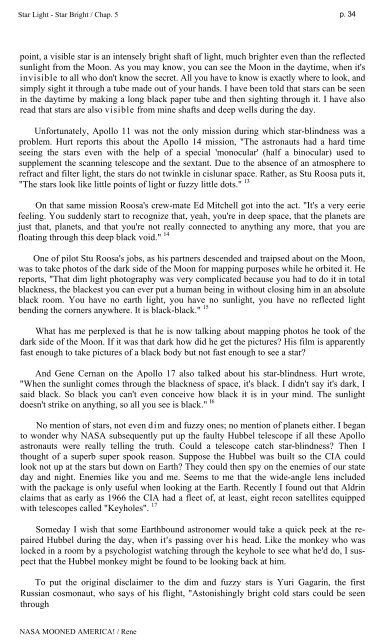Rene-NASA-Mooned-America
Rene-NASA-Mooned-America
Rene-NASA-Mooned-America
You also want an ePaper? Increase the reach of your titles
YUMPU automatically turns print PDFs into web optimized ePapers that Google loves.
Star Light - Star Bright / Chap. 5 p. 34<br />
point, a visible star is an intensely bright shaft of light, much brighter even than the reflected<br />
sunlight from the Moon. As you may know, you can see the Moon in the daytime, when it's<br />
invisible to all who don't know the secret. All you have to know is exactly where to look, and<br />
simply sight it through a tube made out of your hands. I have been told that stars can be seen<br />
in the daytime by making a long black paper tube and then sighting through it. I have also<br />
read that stars are also visible from mine shafts and deep wells during the day.<br />
Unfortunately, Apollo 11 was not the only mission during which star-blindness was a<br />
problem. Hurt reports this about the Apollo 14 mission, "The astronauts had a hard time<br />
seeing the stars even with the help of a special 'monocular' (half a binocular) used to<br />
supplement the scanning telescope and the sextant. Due to the absence of an atmosphere to<br />
refract and filter light, the stars do not twinkle in cislunar space. Rather, as Stu Roosa puts it,<br />
"The stars look like little points of light or fuzzy little dots." 13<br />
On that same mission Roosa's crew-mate Ed Mitchell got into the act. "It's a very eerie<br />
feeling. You suddenly start to recognize that, yeah, you're in deep space, that the planets are<br />
just that, planets, and that you're not really connected to anything any more, that you are<br />
floating through this deep black void." 14<br />
One of pilot Stu Roosa's jobs, as his partners descended and traipsed about on the Moon,<br />
was to take photos of the dark side of the Moon for mapping purposes while he orbited it. He<br />
reports, "That dim light photography was very complicated because you had to do it in total<br />
blackness, the blackest you can ever put a human being in without closing him in an absolute<br />
black room. You have no earth light, you have no sunlight, you have no reflected light<br />
bending the corners anywhere. It is black-black." 15<br />
What has me perplexed is that he is now talking about mapping photos he took of the<br />
dark side of the Moon. If it was that dark how did he get the pictures His film is apparently<br />
fast enough to take pictures of a black body but not fast enough to see a star<br />
And Gene Cernan on the Apollo 17 also talked about his star-blindness. Hurt wrote,<br />
"When the sunlight comes through the blackness of space, it's black. I didn't say it's dark, I<br />
said black. So black you can't even conceive how black it is in your mind. The sunlight<br />
doesn't strike on anything, so all you see is black." I6<br />
No mention of stars, not even dim and fuzzy ones; no mention of planets either. I began<br />
to wonder why <strong>NASA</strong> subsequently put up the faulty Hubbel telescope if all these Apollo<br />
astronauts were really telling the truth. Could a telescope catch star-blindness Then I<br />
thought of a superb super spook reason. Suppose the Hubbel was built so the CIA could<br />
look not up at the stars but down on Earth They could then spy on the enemies of our state<br />
day and night. Enemies like you and me. Seems to me that the wide-angle lens included<br />
with the package is only useful when looking at the Earth. Recently I found out that Aldrin<br />
claims that as early as 1966 the CIA had a fleet of, at least, eight recon satellites equipped<br />
with telescopes called "Keyholes". 17<br />
Someday I wish that some Earthbound astronomer would take a quick peek at the repaired<br />
Hubbel during the day, when it's passing over his head. Like the monkey who was<br />
locked in a room by a psychologist watching through the keyhole to see what he'd do, I suspect<br />
that the Hubbel monkey might be found to be looking back at him.<br />
To put the original disclaimer to the dim and fuzzy stars is Yuri Gagarin, the first<br />
Russian cosmonaut, who says of his flight, "Astonishingly bright cold stars could be seen<br />
through<br />
<strong>NASA</strong> MOONED AMERICA! / <strong>Rene</strong>


